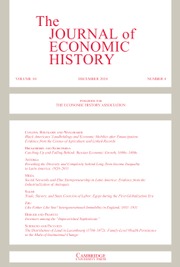Reading about the proliferation of financial bubbles that the COVID-19 pandemic seems to have spawned in 2020, which have gone beyond BITCOIN to include Special Purpose Acquisition Companies (SPACs) and Non-Fungible Tokens (NFTs), economic historians will appreciate reading Quinn and Turner’s brief survey of past financial bubbles. They will get not only a historical perspective on what we are enduring now but also a useful analytical framework for understanding what pleasures and pains may be possible from the ongoing financial bubbles, which are sure to proliferate. Out of many possible case studies, the authors have picked 10 that have occurred over the past three centuries in three different continents. Their selection of bubbles to examine in detail was determined empirically—the price of a marketed asset had to double in less than three years, then collapse by half over the next three years or less. They begin with the Mississippi and South Sea Bubbles in 1719–1720, continue with the Latin American bond bubbles in 1822–1825, cover the railway mania in 1844–1846, the Australian land boom of the 1880s, the British bicycle bubble in 1896–1898, the Wall Street bubble of 1929, the Japanese bubble of the 1980s, the dot-com bubble in the United States, 1999–2000, the sub-prime bubble of 2008, before ending with the repeated Chinese stock market and property bubbles in the twenty-first century. These were all big bubbles, well-documented, and studied by other scholars as well. What do Quinn and Turner bring to the table that makes their treatment both interesting and timely?
As elaborated in Charles P. Kindleberger’s classic work, Manias, Panics, and Crashes: A History of Financial Crises (seven editions to date and counting!), they acknowledge the importance of new opportunities for investments that seize the imaginations of adventurous individuals, who will indulge their bets if easy credit is available. To sources of credit and accessible public markets—two essential ingredients of financial bubbles—Quinn and Turner add the importance of public information. The social media available at each time and place must keep increasing the number and enthusiasm of participants to keep the bubble blowing up. The publicity attending each of the bubbles they discuss makes their book entertaining to read. It is their analytical framework, “The Bubble Triangle,” however, that makes their contribution useful, as well for appraising the plethora of financial bubbles that are currently proliferating.
Analogous to the three elements needed for a fire: oxygen, fuel, and heat, they posit that financial bubbles need marketability, money and credit, and speculation. The amount of speculation needed to “spark” the beginning of a bubble is but a fraction of what will occur at its peak. It is the social media that are responsible for fanning the increasing volume of speculation that will make and has made financial bubbles so striking. To test the usefulness of their framework, they pick 10 financial bubbles that have been examined intensively by scholars, including three they have examined intensively themselves. (Most readers of this Journal will want to see if their own contributions are cited, but this reviewer must warn you in advance that Quinn and Turner keep their focus on the specific aspects of each financial bubble that correspond to one of the sides of their bubble triangle. Consequently, they ignore other aspects of a specific bubble that other scholars may have emphasized in their work. Bearing this in mind will give others some solace, perhaps, as it has given me.)
To summarize the results of their investigation of the successive bubbles in terms of causes and consequences, they identify two variants of the spark or “new new thing” that ignites a given bubble, either new technology or a new government policy, and sometimes a combination of the two. The railway and bicycle manias, as well as the dot-com bubble, fall into the new technology-driven class of bubbles. Most of the other bubbles are initiated, in their view, by government initiatives, especially the initial Mississippi and South Sea bubbles, as well as the Latin American debt crisis, followed by the Australian land boom and even the Wall Street crash in 1929 following the roaring ‘20s. The consequences of the collapse of the various bubbles vary within each category of cause, however. The end of the bicycle mania and the dot-com bubbles simply solidified the hold of leading companies in the technology that sparked the bubble, but the railway mania ended with an over-extended network that plagues the efficiency of the British rail system to this day, in the authors’ opinion, at least. (An American reviewer has a different perspective, it has to be said!)
Government-inspired bubbles, unfortunately, can have long-term, deleterious consequences, as was the case for Australia’s land boom at the end of the nineteenth century, the Wall Street crash worldwide in the 1930s, the lost decade of growth for Japan in the 1980s, and the sub-prime crisis, which they extend beyond the United States to include Ireland, Spain, and Greece. By contrast, they find that the government-initiated, and propelled, stock market bubbles in China have, at least to date, ended with only minor consequences due to effective management of the effects by an increasingly authoritarian government. The publication of their work has been delayed due to the ongoing economic disruption caused by the COVID-19 pandemic, but no doubt the authors are viewing with interest the spate of financial bubbles emerging worldwide as governments provide more fuel in the form of financial subsidies for computer-savvy day-traders to combine via social media to create all sorts of bubbles for the foreseeable future. Pick the SPAC you want to put your money in or watch the price of your NFT keep rising!


